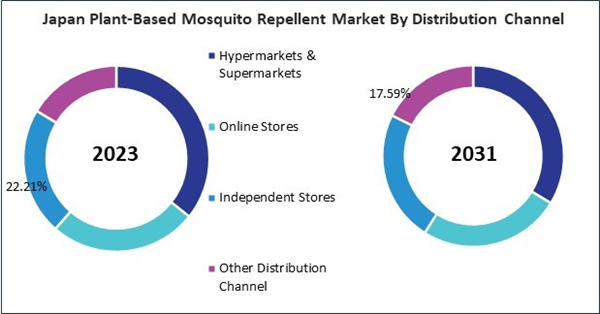The Asia Pacific Plant-based Mosquito Repellent Market is expected to witness market growth of 10.2% CAGR during the forecast period (2024-2031).
The China market dominated the Asia Pacific Plant-Based Mosquito Repellent Market by Country in 2023, and is expected to continue to be a dominant market till 2031; thereby, achieving a market value of $349.4 million by 2031. The Japan market is registering a CAGR of 9.6% during 2024-2031. Additionally, the India market is expected to showcase a CAGR of 11% during 2024-2031.
Plant-based mosquito repellents are formulated using natural ingredients such as essential oils extracted from plants like citronella, eucalyptus, peppermint, lavender, and lemongrass. In traditional medicine and indigenous practices, these ingredients have been employed for centuries to repel insects. However, they are currently being incorporated into contemporary formulations to meet the demand for safer and more natural repellent alternatives.
Moreover, consumers increasingly prioritize products that protect them from mosquito bites and minimize the risk of adverse health effects. Studies have brought attention to the potential health risks associated with continuous exposure to synthetic chemicals found in traditional repellents.
The Asia-Pacific region's plant-based mosquito repellent market is experiencing substantial development. The region's diverse climates, ranging from tropical to temperate, make it prone to mosquito infestations, creating a strong demand for mosquito repellents. In India, the increasing prevalence of mosquito-borne diseases like dengue and malaria is a key factor driving the demand for plant-based mosquito repellents.
The China market dominated the Asia Pacific Plant-Based Mosquito Repellent Market by Country in 2023, and is expected to continue to be a dominant market till 2031; thereby, achieving a market value of $349.4 million by 2031. The Japan market is registering a CAGR of 9.6% during 2024-2031. Additionally, the India market is expected to showcase a CAGR of 11% during 2024-2031.
Plant-based mosquito repellents are formulated using natural ingredients such as essential oils extracted from plants like citronella, eucalyptus, peppermint, lavender, and lemongrass. In traditional medicine and indigenous practices, these ingredients have been employed for centuries to repel insects. However, they are currently being incorporated into contemporary formulations to meet the demand for safer and more natural repellent alternatives.
Moreover, consumers increasingly prioritize products that protect them from mosquito bites and minimize the risk of adverse health effects. Studies have brought attention to the potential health risks associated with continuous exposure to synthetic chemicals found in traditional repellents.
The Asia-Pacific region's plant-based mosquito repellent market is experiencing substantial development. The region's diverse climates, ranging from tropical to temperate, make it prone to mosquito infestations, creating a strong demand for mosquito repellents. In India, the increasing prevalence of mosquito-borne diseases like dengue and malaria is a key factor driving the demand for plant-based mosquito repellents.
List of Key Companies Profiled
- S.C. Johnson & Son, Inc.
- Reckitt Benckiser Group PLC
- Henkel AG & Company, KGaA
- Spectrum Brands Holdings, Inc.
- Johnson & Johnson Services, Inc. (Johnson & Johnson)
- Dabur India Ltd.
- Natura & Co Holding SA
- 3M Company
- Godrej Consumer Products Ltd. (Godrej Group)
- Himalaya Wellness Company (Himalaya Global Holdings Ltd.)
Market Report Segmentation
By End-Use- Household
- Commercial
- Other End-Use
- Adults
- Children
- Other Age Group
- Sprays & Aerosols
- Lotions & Creams
- Candles & Coils
- Other Product Type
- Hypermarkets & Supermarkets
- Online Stores
- Independent Stores
- Other Distribution Channel
- China
- Japan
- India
- South Korea
- Singapore
- Malaysia
- Rest of Asia Pacific
Table of Contents
Chapter 1. Market Scope & Methodology
Chapter 2. Market at a Glance
Chapter 3. Market Overview
Chapter 4. Asia Pacific Plant-Based Mosquito Repellent Market by End-Use
Chapter 5. Asia Pacific Plant-Based Mosquito Repellent Market by Age Group
Chapter 6. Asia Pacific Plant-Based Mosquito Repellent Market by Product Type
Chapter 7. Asia Pacific Plant-Based Mosquito Repellent Market by Distribution Channel
Chapter 8. Asia Pacific Plant-Based Mosquito Repellent Market by Country
Chapter 9. Company Profiles
Companies Mentioned
Some of the key companies profiled in this Asia Pacific Plant-Based Mosquito Repellent Market include:- S. C. Johnson & Son, Inc.
- Reckitt Benckiser Group PLC
- Henkel AG & Company, KGaA
- Spectrum Brands Holdings, Inc.
- Johnson & Johnson Services, Inc. (Johnson & Johnson)
- Dabur India Ltd.
- Natura & Co Holding SA
- 3M Company
- Godrej Consumer Products Ltd. (Godrej Group)
- Himalaya Wellness Company (Himalaya Global Holdings Ltd.)
Methodology

LOADING...









